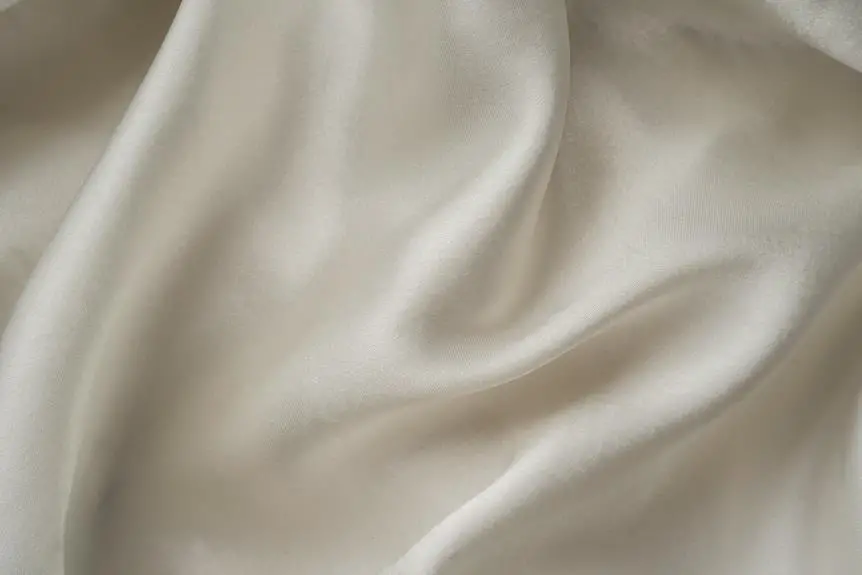Wondering if satin fabric reveals perspiration? Satin's luxurious sheen can make sweat less noticeable, but it's not immune to showing moisture. Understanding how satin interacts with sweat and learning effective management techniques can help you maintain a pristine appearance.
In this guide, you'll explore the properties of satin fabric, factors affecting sweat visibility, tips for managing sweat on satin, best practices for preventing sweat marks, and cleaning and maintenance of satin. By the end, you'll have the mastery to confidently enjoy the elegance of satin without worrying about sweat.
Let's delve into the intricacies of satin and sweat, so you can keep your garments looking their best.
Key Takeaways
- Satin fabric has a smooth and glossy surface, making it a popular choice for luxurious clothing and bedding.
- The tightly woven structure of satin fabric reduces airflow, but advancements in fabric technology have led to moisture-wicking variations that can help manage sweat.
- The fabric composition, including the type of fibers used and the weave structure, can affect sweat absorption and breathability.
- The color of satin fabric can impact sweat visibility, with darker colors being more forgiving and lighter colors being more likely to reveal sweat marks.
Properties of Satin Fabric
Satin fabric has a smooth and glossy surface, making it a popular choice for luxurious clothing and bedding. Its elegant sheen and soft feel lend a touch of sophistication to any garment or linen.
When it comes to breathability, satin fabric may not be the most ideal choice. Its tightly woven structure reduces airflow, which can lead to less effective moisture management. This means that satin fabric may not be the best option for managing sweat, as it can trap moisture against the skin.
However, advancements in fabric technology have led to the development of moisture-wicking satin fabric, which offers improved breathability and sweat management. These innovative satin fabrics provide the luxurious feel of satin while addressing the need for breathability and moisture control.
When selecting satin clothing or bedding, consider opting for these moisture-wicking variations to enjoy the comfort and elegance of satin without compromising on breathability and sweat management.
Factors Affecting Sweat Visibility
When it comes to sweat visibility on satin fabric, several factors come into play. The composition of the fabric, the color, and any finishing treatments can all affect how much sweat shows on the material.
Understanding these key points will help you make informed choices about satin garments and manage sweat visibility effectively.
Fabric Composition and Sweat
If you sweat, satin fabric can still show it due to its smooth surface and composition, which can highlight moisture more visibly.
When it comes to fabric composition and sweat, here are three factors to consider:
- Fiber Types: The type of fibers used in satin fabric can affect its ability to absorb sweat. Natural fibers like silk and cotton tend to be more breathable and better at absorbing moisture, while synthetic fibers like polyester may trap sweat and make it more visible on the fabric.
- Weave Structure: The weave structure of satin fabric can impact its breathability. Tight weaves may restrict airflow and trap sweat, whereas looser weaves allow for better ventilation and moisture evaporation.
- Fabric Finishes: Certain fabric finishes, such as moisture-wicking or quick-drying treatments, can help minimize the visibility of sweat on satin fabric by enhancing its ability to manage moisture.
Understanding these factors can help you choose satin fabric that's less likely to show sweat.
Color and Sweat Visibility
To minimize the visibility of sweat on satin fabric, consider the impact of color on sweat visibility. Dark colors like navy blue, black, and dark grey tend to be more forgiving when it comes to showing sweat stains. These colors absorb and mask sweat, making it less noticeable.
On the other hand, lighter colors such as white, pastels, and light grey are more likely to reveal sweat marks. The contrast between the fabric color and the sweat can make stains more apparent.
When choosing satin clothing to wear in situations where sweat may be a concern, opting for darker colors can help reduce the visibility of sweat stains, allowing you to feel more confident and comfortable throughout the day.
Finishing Treatments and Sweat
Consider the finishing treatments applied to satin fabric, as they significantly influence the visibility of sweat stains. When it comes to sweat management and fabric finishes, the type of finishing treatment plays a crucial role in determining how visible sweat will be on satin fabric:
- Moisture-wicking finishes: Some satin fabrics are treated with moisture-wicking finishes that help to draw sweat away from the skin and disperse it across the fabric's surface, reducing the visibility of sweat stains.
- Stain-resistant finishes: Certain fabric finishes create a barrier that repels sweat, preventing it from seeping into the fabric and making sweat stains less noticeable.
- Breathable finishes: Finishes that enhance the breathability of satin fabric can aid in sweat evaporation, minimizing the likelihood of visible sweat marks.
Understanding these fabric properties and sweat management techniques can help in choosing the right satin fabric for different purposes.
Tips for Managing Sweat on Satin
Here are five effective ways to manage sweat on satin fabric and keep it looking fresh and clean.
Firstly, prioritize sweat management by wearing breathable, moisture-wicking undershirts or garment liners under satin clothing. These underlayers help to absorb sweat and prevent it from reaching the outer satin fabric.
Secondly, consider using antiperspirant products to minimize sweating, especially in areas prone to perspiration.
Additionally, be mindful of fabric care by promptly addressing any sweat stains. Blot the affected area with a clean cloth and mild detergent, then gently rinse with cold water. Avoid rubbing, as this can damage the delicate satin fibers. Furthermore, allow the fabric to air dry completely before wearing or storing.
To maintain satin breathability and moisture control, store clothing in a well-ventilated area and avoid plastic garment bags, which can trap moisture.
Lastly, consider consulting with a professional dry cleaner for stubborn or extensive sweat stains to ensure proper treatment without compromising the fabric.
Best Practices for Preventing Sweat Marks
Maintain satin fabric's freshness and prevent sweat marks by choosing breathable undershirts or garment liners to absorb perspiration and protect the delicate fabric. When it comes to preventing stains and maintaining the pristine appearance of your satin garments, consider these best practices:
- Fabric Selection: Opt for breathable fabrics like cotton or moisture-wicking materials for your undershirts or garment liners. These materials help to draw moisture away from the skin, preventing sweat from reaching the satin fabric and reducing the likelihood of sweat marks.
- Hygiene Habits: Practice good personal hygiene by using antiperspirants or deodorants to minimize sweating. Additionally, consider using sweat-absorbing powder or antiperspirant wipes to keep sweat at bay and maintain the freshness of your satin garments.
- Washing and Care: Follow the care instructions for your satin garments carefully, and consider using fabric-friendly stain removers or spot treatments to address any sweat marks promptly. Proper care and maintenance will help to preserve the fabric's breathability and prevent sweat marks from becoming a permanent issue.
Cleaning and Maintenance of Satin
To keep your satin fabric looking its best, regularly spot treat any sweat marks and follow the specific care instructions provided for satin garments.
When it comes to cleaning satin, delicate handling is key. Always check the care label for any specific fabric care instructions, as different satin blends may have different cleaning requirements.
For general cleaning tips, gently hand wash satin in cold water using a mild detergent, and avoid wringing or twisting the fabric to prevent damage. If machine washing is recommended, use a gentle cycle and place the garment in a mesh laundry bag to minimize friction.
When it comes to stain removal, it's important to address any marks promptly. Blot the stained area with a clean cloth and mild detergent, then rinse with cold water. Avoid using hot water, as it can set the stain. For tougher stains, consider taking the garment to a professional dry cleaner who specializes in handling delicate fabrics.
With proper care and maintenance, your satin garments can retain their luxurious look and feel for years to come.
Conclusion and Final Thoughts
As you consider the breathability of satin fabric and ways to manage sweat on it, keep in mind some practical care tips to maintain its quality.
Understanding how satin fabric interacts with sweat and how to handle it will help you make informed decisions about incorporating satin into your wardrobe.
Satin Fabric Breathability
You should consider satin fabric's breathability when choosing clothing for warm weather. Satin fabric breathability is an important factor to keep in mind, especially if you want to stay comfortable and cool. Here are three key points to consider:
- Breathability: Satin fabric tends to have lower breathability compared to natural fibers like cotton or linen. This means it may not allow for as much air circulation, potentially leading to a warmer and more humid feel.
- Moisture Wicking Properties: Satin fabric may not have the best moisture-wicking properties, which can result in sweat being trapped against the skin, leading to discomfort.
- Layering: If you still want to wear satin in warm weather, consider layering it with breathable, moisture-wicking fabrics to help mitigate its lack of breathability and moisture-wicking abilities.
Managing Sweat on Satin
When managing sweat on satin, focus on wearing breathable layers to minimize discomfort. Satin fabric is known for its smooth and luxurious feel, but it can pose challenges when it comes to moisture control. To effectively manage sweat on satin, consider the fabric's breathability and opt for moisture-wicking undergarments. Additionally, implementing proper care tips, such as gentle washing and air drying, can help maintain the fabric's integrity while managing sweat. Here's a table summarizing key points for managing sweat on satin:
| Moisture Control | Fabric Breathability | Care Tips |
|---|---|---|
| Wear breathable layers | Choose satin with good breathability | Gentle washing and air drying |
| Opt for moisture-wicking undergarments | Avoid tight-fitting satin clothing | Avoid high heat when drying |
Satin Care Tips
To effectively maintain the luxurious feel of satin and minimize sweat-related issues, prioritize gentle care and thoughtful fabric choices.
When it comes to satin care, consider the following tips:
- Gentle Cleaning: Opt for hand washing or using the delicate cycle on your washing machine to prevent damage to the delicate fibers of satin fabric. Use a mild detergent and avoid harsh chemicals.
- Air Drying: Allow satin fabric to air dry instead of using a dryer to preserve its sheen and smooth texture.
- Storage: Store satin garments in a cool, dry place away from direct sunlight to prevent discoloration and maintain their quality.
Frequently Asked Questions
Can Satin Fabric Be Effectively Treated to Resist Sweat Stains?
Yes, satin fabric can be effectively treated to resist sweat stains. Satin fabric treatments can make it sweat-resistant, and you can find a variety of colors specifically designed to hide any potential sweat marks.
Are There Specific Colors or Patterns of Satin Fabric That Are Less Likely to Show Sweat?
When choosing satin fabric colors and patterns, opt for darker shades and busy prints to minimize the appearance of sweat. Additionally, consider sweat-resistant satin treatments to further reduce the visibility of sweat stains on your fabric.
Can Wearing an Undershirt Help Prevent Sweat From Showing on Satin Fabric?
Wearing an undershirt can help prevent sweat from showing on satin fabric. The undershirt acts as a barrier and absorbs sweat, keeping your satin clothing dry and stain-free. It's a simple way to maintain a polished appearance.
Are There Any Specific Types of Deodorant or Antiperspirant That Are Better for Preventing Sweat Marks on Satin?
To prevent sweat marks on satin, look for sweat-resistant fabrics or try using a clinical-strength antiperspirant. Also, consider satin care and fabric maintenance tips. These alternative solutions can help you keep your satin looking fresh and sweat-free.
What Are Some Alternative Fabrics or Materials That Are Less Likely to Show Sweat Compared to Satin?
Looking for fabric alternatives to satin that are less likely to show sweat? Consider moisture-wicking materials like bamboo or sweat-resistant coatings on breathable fabrics such as linen. These options can help minimize the appearance of sweat.
- How Do I Remove Those Stubborn, Hard-to-Get-Rid-Of Fabric Pills? - June 10, 2025
- Why Do My Athletic Clothes and Activewear Pill So Much? - June 10, 2025
- How Does Fabric Weave (Knit vs. Woven) Affect Its Tendency to Pill? - June 10, 2025






